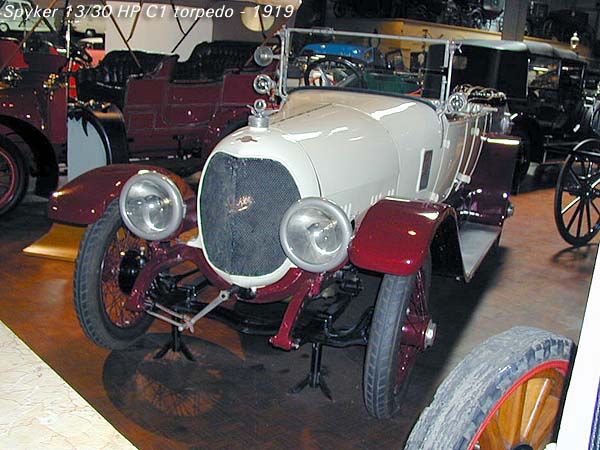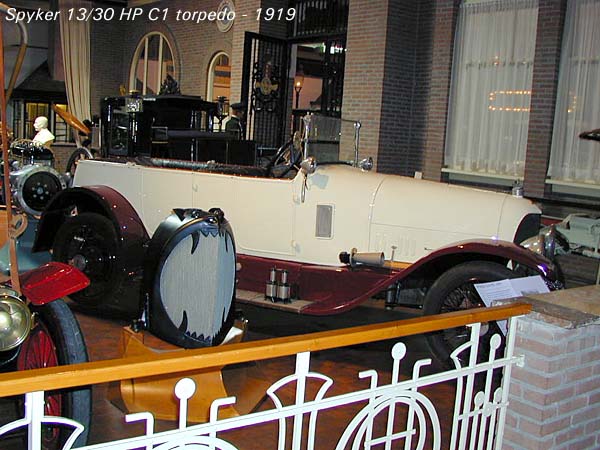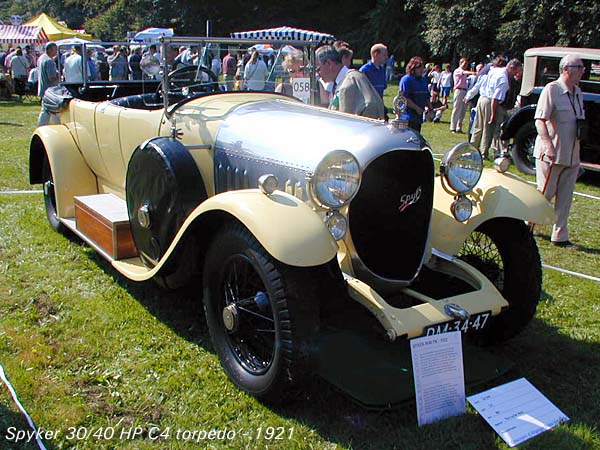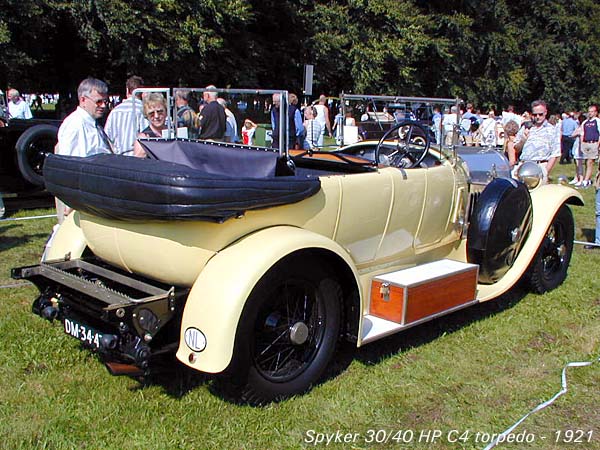|
 By
1913 the Trompenburg company, owner of Spyker, had ran into financial trouble
again. The main reason of that was the limited production of cars combined with
large investments in development and production. This first lead to a management
change and then to a take-over in 1915. The new owners of the company were Dutch
entrepreneurs who where planning to start aircraft production. Also the company
suffered a nasty blow when main engineer Laviolette left the company in 1913. By
1913 the Trompenburg company, owner of Spyker, had ran into financial trouble
again. The main reason of that was the limited production of cars combined with
large investments in development and production. This first lead to a management
change and then to a take-over in 1915. The new owners of the company were Dutch
entrepreneurs who where planning to start aircraft production. Also the company
suffered a nasty blow when main engineer Laviolette left the company in 1913.
After the take-over the company was renamed (translated) the "Dutch Car and
Aircraft Factory Trompenburg plc." and a new logo was introduced, depicting
a spoke wheel with a big horizontal propeller across. Also a new company motto
was incorporated into the logo: "Nulla tenaci invia est via", Latin
for "no road is impenetrable for him who perseveres". Aptly chosen for
a company that already had survived two bankruptcies.
 After
the departure of Laviolette the decision was made to reduce the number of models
and engines and to develop one model to replace them all. Inspired by the
American Cadillacs engineer Smit Kleine set out to design a modern and reliable
car. After
the departure of Laviolette the decision was made to reduce the number of models
and engines and to develop one model to replace them all. Inspired by the
American Cadillacs engineer Smit Kleine set out to design a modern and reliable
car.
In 1916 this new car was introduced to the public: the 13/30 HP C1. The C1
designation indicated Chassis type 1, a new naming system for the Spyker
cars after the take-over and equivalent to the names for the Spyker aircraft
(types V1 to V4, where V stood for "Vliegtuig", Dutch for
airplane). Only after the end of WW 1 in 1918 this model became available to the
public, due to supply difficulties for the foreign (American) parts this model
needed.
The C1 looked the business with its V-shaped radiator and
elegantly rounded design, but it was a bit of a disappointment. In the design
rigidity and reliability was carried too far and so the chassis was
exceptionally heavy. The new and conventional 4-cylinder 3562 cc unit produced a
mere 45 hp and by that the car was regarded as underpowered. Besides that the
engine suffered from poor carburetion, the gear ratios didn't fit the car very
well and there were problems producing effective camshafts now Spyker had
changed back from the transverse to the normal longitudinal placement.
Still, the C1 was a high-quality and durable car which was improved regularly
during its production run up to 1921. Best known C1 is the 1919
"Aerocoque" with extravert streamlined bodywork inspired by aircraft
design, a two-seater intended as a show car but also produced on a very limited
scale. In 1920 a more powerful C1 version was advertised, the 14/34 HP C1, to
oblige those who felt the regular C1 was too slow.
The only Spyker C1 which has survived to this day is the 1919 torpedo model you
see on these pictures. It is in original state and was owned by a Mr. Spurbeon
who lived in Australia.
 In
1920 the Spyker C2 came on the market, a 2 ton truck with a 4607 cc 4-cylinder
Continental engine delivering 35 hp. The C3 remains somewhat of an enigma, but
was probably a prototype for a sporty 2-seater roadster which wasn't taken into
production. In
1920 the Spyker C2 came on the market, a 2 ton truck with a 4607 cc 4-cylinder
Continental engine delivering 35 hp. The C3 remains somewhat of an enigma, but
was probably a prototype for a sporty 2-seater roadster which wasn't taken into
production.
And then, in 1920, the 30/40 HP C4 appeared. On one hand this car proved to be
Spyker's piece de resistance (masterpiece if you will) and on the other, sadly,
its swan song.
Special about the C4 was that it was constructed around top quality parts made
by other companies, rather than making everything themselves like Spyker was
used too. The most important part, the engine, came from the German Maybach
factory. This illustrious company was founded by Wilhelm Maybach, the engineer
responsible for the first Mercedes and renown for his technical innovations
during the early days of motoring.
In 1907 Maybach left the Daimler company and founded his own
engineering works with as main objective to produce engines for the airships of
his friend Count Zeppelin. After the first World War Germany was prohibited to
built aircraft, so Maybach turned to car production again. At first only as an
engine manufacturer and the first car engine the company produced was a straight
6-cylinder overhead-valve unit with 5742 cc displacement producing 72 hp. Only
one customer could be found for this engine: the Dutch Spyker company. Spyker
promised to purchase a few hundred of these engines for their new C4 model, but
unfortunately this estimate was much to optimistic and in the first production
year only a fraction of this amount was actually delivered to Spyker.
Maybach needed to sell much more engines to survive, and so the company decided
to produce complete cars themselves. The first, the W3 model, was introduced in
1921 and soon Maybach established itself as a top quality car manufacturer,
leading to the introduction of the world famous DS7 "Zeppelin" model
in 1930. This was a extremely opulent and expensive car with a silky smooth 7
litre V12 under the bonnet.
For Spyker this was somewhat of a bitter pill to swallow. Their engine supplier
turning into a direct competitor in the market they had so desperately tried to
establish themselves into for decades wasn't a good sign.
 But
the Maybach 6-cylinder worked really well for the C4. It was powerful,
dependable and comfortable and gave the car a top speed of up to 140 kph.
Special was the double ignition system with Bosch high-tension magneto and
battery-coil ignition with two spark plugs per cylinder. But
the Maybach 6-cylinder worked really well for the C4. It was powerful,
dependable and comfortable and gave the car a top speed of up to 140 kph.
Special was the double ignition system with Bosch high-tension magneto and
battery-coil ignition with two spark plugs per cylinder.
Amongst the other external components used was the gearbox made by Leflaive
& Cie from France after an original Spyker design. A wide range of bodywork
styles were available for the C4, but most popular were the open-top types like
the torpedo and cabriolet.
The yellow C4 with aluminum bonnet shown here was sold to Mrs. Baizly from
Australia in 1921. In 1996 it was brought back to The Netherlands by enthusiasts
and now its owned by the National Bicycle Museum "Velorama".
|
